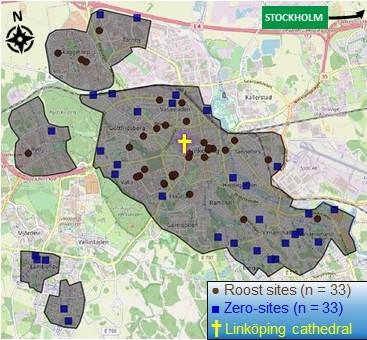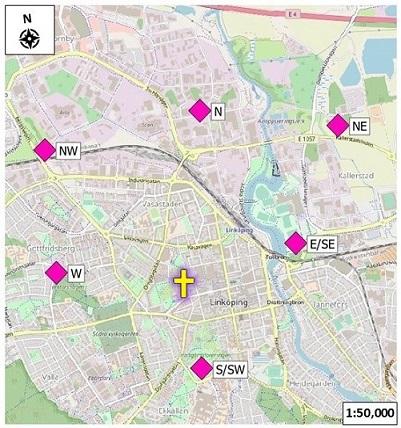Methods
Inventories

When doing the inventories (autumn 2018 + winter 2019), all communally roosting individuals were counted, and notes taken on ambient conditions within 200 m of the roost sites. That enabled for comparative analyses later - seasonal differences, roost sites v zero-sites differences, and factors influencing the number of individuals at the roost.
The zero-sites were randomised points within the inventory area, excluding roost sites.
Variables measured during inventories:
- Number of individuals
- Temperature
- Wind
- Roost height
- Mean height of buildings, 50 m radius
- Roof complexity, 50 m radius
- Amount of foraging area, 200 m radius
- Canopy cover, 200 m radius
- Grand total of large (> 1 ha) green areas, 1,500 m radius
Flight lines

To assess if the jackdaws were equally spread out in the country-side surrounding Linköipng, six observation points covering eight in-flight directions of the compass were chosen. All six points had good visibility towards its direction/s, as well as towards the cathedral bell-tower.
Flight lines data was collected six consecutive days per month, from August to December 2018, from approximately 90 minutes before sunset, until sunset. The timing was chosen based on earlier studies' recommendations.
Extra: Methodology testing
Arrival timing and roost behaviour
Additionally, I assessed two more things.
- How well did the suggested timing for flight lines observations fit reality for my study?
In December 2018, I tried this by staying at each observation point for another two hours, counting the number of 'late arrivals'.
- Fluxes of individuals between roosts: Once a flock of roosting jackdaws was encountered and accounted for at a specific site during the inventories, how could I be certain the flock didn't leave, risking me double counting birds?
In a similar fashion as above, I stayed for about three hours post-sunset, at four separate roost sites, in the evenings of December, to estimate the movement of individuals to and from the roosts.
The above-mentioned times were picked after consulting earlier studies and literature on roost arrival timing, and sleep patterns, for jackdaws.
Responsible for this page:
Director of undergraduate studies Biology
Last updated:
05/07/19
